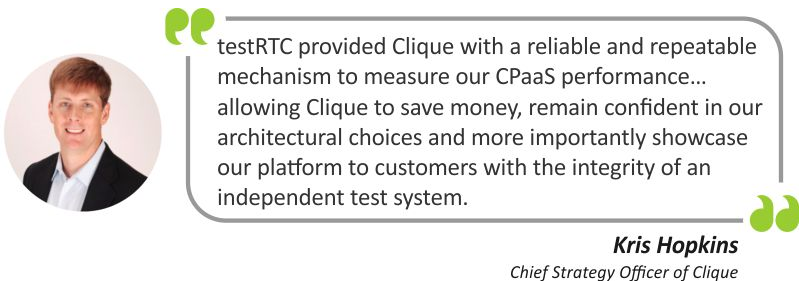
How Clique Migrated Smoothly to the Newest AWS EC2 C5 Instance
In a need to focus resources on core activities, Clique Communications turned to testRTC for stress testing and sizing.
Clique API provides web-based voice and text application programming interfaces. In their eight years of existence, they have grown to support over 20 million users across 150 countries. This amounts to over 500 million minutes per month. Clique’s cloud services deliver multi-party voice that can be embedded by enterprises into their own business processes.
What are their current goals?
- Grow the business
- Add features to improve customer service and experience
- Offer value-added services
Adding WebRTC
Clique started working with WebRTC some 18 months ago with customers starting to use it at the end of 2017.
Today, Clique supports all major browsers – Chrome, Firefox, Safari, and Edge; enabling its customers to offer uninterrupted interactions with their users. When a user joins a conference, he/she can do so over PSTN, directly from the browser or from within a native application that utilizes Clique SDKs.
Making Use of testRTC
As with any other software product, Clique had to test and validate its solution. To that end, Clique had already been using tools for handling call volumes and regression, testing the application and the SDKs. The challenge was the issue of scalability and quality of service, which is essential when it comes to WebRTC support. Clique had a decision to make – either invest in building their own set of testing tools on top of open source frameworks such as Selenium, or opt for a commercial alternative. They decided to go with the latter and use testRTC. They also preferred using a third party tool for testing as they didn’t want to burden their engineering team.
Switching from AWS EC2 C4 to C5
Clique had previously used a standard instance on Amazon from the AWS EC2 C4 series but when the AWS EC2 C5 series came out, they wanted to take advantage of it – not only was it more economical but it also had better performance. Furthermore, knowing Amazon would release newer sets of servers that would need to be tested again, Clique required this process to be repeatable.
The Action Plan
Since Clique is an embeddable service, they decided it was most strategic to have a third party develop an application using the Clique client SDK and APIs, and use that application as a test framework that could scale and grow the performance of the platform. It was a wonderful opportunity to optimize their own resources and save on the instances that they deploy on Amazon. An added bonus was having a third party that could then be used by Clique’s customers and partners who are building applications hey can use as part of their development process.
Clique wrote their own test scripts in testRTC. The main test scenario for Clique was having a moderator who creates the conference and then generates a URL for other participants in the conference to join. Once they figured out how to do that with testRTC, the rest was a piece of cake.
Using testRTC to assist in sizing the instances on the AWS has ancillary benefits beyond Clique’s core objectives. Clique tested the full life-cycle of its solution. From developing yet another application with its SDKs, integrating its APIs, to continuous integration & devops, Clique discovered bugs that were then fixed, optimized performance and gave Clique confidence to run services at scale in next generation architectures.

“testRTC provided Clique with a reliable and repeatable mechanism to measure our CPaaS performance… allowing Clique to save money, remain confident in our architectural choices and more importantly showcase our platform to customers with the integrity of an independent test system.”
Moving Forward – Continued use of testRTC
There are a lot of moving pieces in Clique’s solution: infrastructure in the backend, media servers , the WebRTC gateways. Features such as recording can fit into various components within the architecture, and Clique is always looking for ways to optimize and simplify.
testRTC helps Clique evaluate if the assumptions made in their architecture are valid by determining bottlenecks and identifying places of consolidation.
In the future, Clique will be looking at testRTC’s monitoring capability as well as using testRTC to instantiate browsers in different locations.
